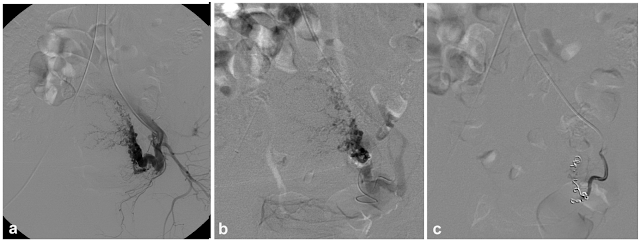Uterine Artery Embolization with Gelfoam for Acquired Symptomatic Uterine Arteriovenous Shunting
Clinical Question
To evaluate the technical and clinical success rates and safety of bilateral gelfoam uterine artery embolization (UAE) for symptomatic acquired uterine arteriovenous shunting due to prior obstetric or gynecologic event.
Take-away Point
Gelfoam embolization of bilateral uterine arteries is effective in treating abnormal uterine bleeding secondary to AV shunting caused by gynecologic or obstetric intervention and allowed for future pregnancy.
Reference
Camacho A, Ahn E, Appel E, Boos J, Nguyen Q, Justaniah A, Faintuch S, Ahmed M, Brook O. (2019). Uterine Artery Embolization with Gelfoam for Acquired Symptomatic Uterine Arteriovenous Shunting. J Vasc Interv Rad, 30:1750-1758. doi:10.1016/j.jvir.2019.04.002
Click here for abstract:
Study Design
Retrospective single center study
Funding Source
Self-funded
Setting
Dept of Radiology, Beth Isreal Deaconess Medical Center; Department of Diagnostic and Interventional Radiology, University Dusseldorf

Figure 3. A 39-year-old G1P1 with continued heavy bleeding after cesarean delivery concerning on ultrasound for arteriovenous shunting, (a) Left uterine arteriogram shows a large-caliber shunt into the left internal iliac vein. (b) Gelfoam alone was insufficient to close the shunt. (c) Coils were used to complete the occlusion.
Summary
A retrospective review from Jan 2013 – Feb 2018 was performed at a tertiary referral center for gelfoam UAE’s performed for abnormal uterine bleeding after recent gynecologic procedure or obstetric event. All patients had suspected or known uterine AV shunting based on pre-procedural imaging with ultrasound +/- MRI. 18 patients who underwent 19 UAEs were evaluated. Average peak systolic velocity on ultrasound was 59.8 ± 40.9 cm/s with RI of 0.45 ± 0.13. Technical success was angiographic resolution of the AV shunting and clinical success was defined as cessation of bleeding, resolution on imaging or <50 cc blood loss on subsequent D&C.
The technical success rate of UAE with gelfoam was 94.4% with one patient requiring additional coil embolization due to the large size of the shunt. A second angiogram was performed on a single patient with pelvic US demonstrating persistent but diminished shunting however no shunt was identified and repeat embolization was not performed. Clinical success rate was 94.1% in the 17 successful UAEs. One minor complication – groin hematoma – and one major complication – pulmonary embolism – occurred in the patient group. Clinical improvement was noted in all patients on follow-up. Seven patients had subsequent pregnancies without placenta accrete although there was one patient with placenta previa.
Commentary
Treatment of abnormal uterine bleeding secondary to gynecological or obstetric intervention can be treated successfully with UAE with a high clinical and technical success rate as demonstrated in this study as well as several others by Wang et al, Ganguli et al and Ghai et al for example. Treatment with gelfoam slurry as opposed to coils, particles or gelfoam pledgets may confer a higher success rate as described by the authors while allowing for increased fertility. Further study is needed to truly assess the post-UAE fertility rate as this was a secondary endpoint and confounded by miscarriages and unplanned terminated pregnancies. Additional study may also define which particle is ideal for preserved fertility as particles are frequently used in the setting of fibroid embolization.
Post Author
Nicole A. Keefe, MD
Fellow, Interventional Radiology
Department of Radiology and Medical Imaging
University of Virginia
@NikkiKeefe
No comments:
Post a Comment
Note: Only a member of this blog may post a comment.